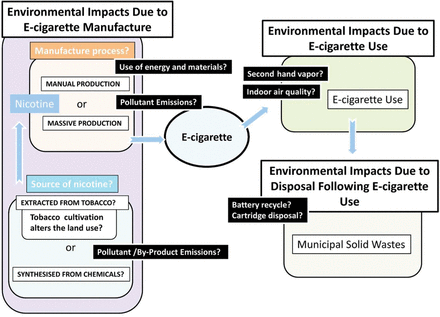top of page
E-CIGARETTE IMPACTS ON THE ENVIRONMENT
175 million refill pods
were sold by Juul within the first quarter of 2019

E-CIGARETTE IMPACTS ON THE ENVIRONMENT ARE PRESENT BUT UNCLEAR
There is very minimal information on how resource intensive and environmentally harmful e-cigarettes are. This doesn't necessarily mean that environmental impacts don't exist for e-cigarettes, but rather stresses how new and secretive this industry is. However, there is a report conducted by Hoshing Chang that outlines the potential environmental impact sources and research questions other researchers could investigate. Below, there are brief descriptions of each stage of an e-cigarette's life, including energy and water intensities, indoor air quality, and recycling programs.
PRODUCTION
More research is necessary to provide concrete statistics on how the production of e-cigarettes impacts the environment. Hover over this box for some factors to consider when evaluating the environmental impacts of e-cigarettes.
-
Tobacco Farming & Land Use Change for Nicotine
-
Nicotine, Metals, & Other Resource Extraction
-
Energy & Water Consumption Associated with Extraction
-
Transporting Resources to Factory
-
Manufacturing & Assembling Products (Small or Large Scale)
-
Energy & Water Associated with Manufacturing
-
Transporting/Delivering Products to Stores or Consumers
-
Externalities
Conducting a Life Cycle Assessment can be a way for researchers to understand the environmental impacts at each stage of an e-cigarette's life.
CONSUMPTION
E-cigarette aerosol emissions are a new source of pollution and toxicants. These devices don't give off smoke like tobacco cigarettes, but their "vapor" may contain harmful substances, mentioned in the "health" tab. We do not know the effects of these aerosols emitted into the environment yet, however these emissions aren't harmless as the e-cigarette industry implies.
The American Institute Hygiene Association cites a St. Helen et al, describing how e-cigarette users retain 93.8% nicotine, 91.7% propylene glycol, and 84.4% vegetable glycerin from vaping emissions, resulting in the rest being a potential source for secondhand exposure. On the other hand, nicotine deposition has been found on surfaces where individuals vape between 50-500 times a day and can remain on clothes for 72 hours after exposure. Additionally, the study also finds that e-cigarette aerosols can travel through HVAC systems and deposit in adjacent buildings.
This indicates that there has been progress on the information known about vaping in surrounding environments, but there are still gaps in knowledge about how vapors could impact the overall health of those nearby or natural environment.

DISPOSAL
E-cigarettes, their batteries, cartridges, and electric circuitry pose human and environmental health risks whether they are reusable or not. When not discarded properly, batteries and cartridges containing e-liquid residual may leach toxic chemicals and metals into nearby water sources. Depending on the composition of these products and dose released, toxicity levels vary from being negligible to posing serious illnesses. E-liquid, for example, may have nicotine and metal residual left in cartridges. Nicotine is listed as an "acute biohazard waste", meaning that it is "fatal to humans in low doses" or is "capable of causing or significantly contributing to an increase in serious, irreversible, or incapacitating, reversible illness."
Hover over these boxes to discover various e-cigarette components that contribute to environmental issues.
E-CIGARETTE DEVICES
E-cigarette devices consist of a battery, cartridge, and electronic circuitry that needs to be disposed of properly. Although these devices may be reused, e-cigarettes end up in landfills or being littered, contributing to a larger waste and biohazard issue.
Each recycling program is different. From accepting the entire e-cigarette to only taking the atomizer or batteries, do some research on what is acceptable for your recycling program.
BATTERIES
Batteries are universally considered as e-waste because the potential fire and health hazards they may pose when discarded improperly. As batteries degrade, they leach metals and chemicals into the environment. Additionally, e-cigarette batteries have been known to cause explosions.
Several recycling programs will take e-cigarettes, but the batteries need to be removed from the device.
CARTRIDGES &
E-LIQUID BOTTLES
Nicotine, found in e-liquid, is considered an "acute biohazard waste" by the Environmental Protection Agency. When e-cigarettes are littered or in landfills, the residual left in cartridges or e-liquid bottles can leach into nearby water sources and pose human and environmental health risks. Even if you try to recycle these components, they usually end up in landfills anyway because they're contaminated with e-liquid or aren't the acceptable types of plastic for the recycling facility.
"DISPOSABLE" DEVICES
Many e-cigarette companies produce disposable devices that contain the same components as conventional cigarettes, but remove the need to charge and refill devices. These companies advertise disposable products as convenient for consumers; however, don't complement these promotions with proper disposal procedures or recycling resources. In 2015, 19.2 million disposable e-cigarettes and refills were produced and inevitably tossed out. Whether they were intentionally discarded in recycling facilities or carelessly thrown in trash bins, it's difficult to quantify the impacts e-cigarettes, their batteries, cartridges, and electric circuitry make.
In addition to affecting our local environment, a large portion of the U.S.'s e-waste is being shipped to developing countries and impacting their environment too (if not recycled in the U.S.). This is an environmental justice issue in how wealthier countries are forcing developing countries to deal with their waste issues. Depending on where our e-waste is going, we have to consider the energy consumed and greenhouse gases released by transporting our items to their destination.
WHERE CAN YOU DISPOSE E-CIGARETTES?
-
E-cigarettes, their batteries, and cartridges are considered e-waste, so find your nearest e-waste bin
-
Contact your waste management company to see how they accept e-waste
-
Visit CalRecycle for e-waste recycling based on the county you live in
-
-
Call2Recycle helps you find your nearest e-waste disposal locations
-
Some locations may not accept cartridges because of the e-liquid potentially present
-
-
-
Drug Enforcement Administration's National Prescription Drug Take Back Day accepts e-cigarettes with batteries removed
-
Next one is on April 25th at various locations nationwide
-
Knowing how to properly dispose e-cigarettes (and really everything) can be ambiguous and confusing. Read each option's instructions for proper disposal or call the company if you ever have questions - they all vary in what components and how products are accepted.
bottom of page
